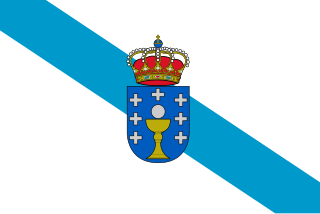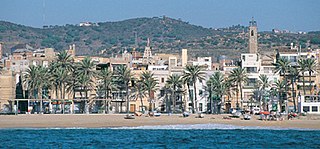
Badalona is a municipality to the immediate north east of Barcelona in Catalonia, Spain. It is located on the left bank of the small Besòs River and on the Mediterranean Sea, in the Barcelona metropolitan area.

The Royal Site of San Lorenzo de El Escorial, commonly known as Monasterio del Escorial, is a historical residence of the King of Spain, in the town of San Lorenzo de El Escorial, about 45 kilometres northwest of the Spanish capital, Madrid. It is one of the Spanish royal sites and has functioned as a monastery, basilica, royal palace, pantheon, library, museum, university, school and hospital. It is situated 2.06 km (1.28 mi) up the valley from the town of El Escorial.

Tlaxcala, officially Tlaxcala de Xicohténcatl, is the capital city of the Mexican state of Tlaxcala and seat of the municipality of the same name. The city did not exist during the pre Hispanic period but was laid out by the Spanish as a center of evangelization and governance after the Spanish conquest of the Aztec Empire. It was designated as a diocese but eventually lost this status to Puebla as its population declined. The city still has many of its old colonial structures including the former Franciscan monastery, as well as newer civic structures such as the Xicohténcatl Theater.

The Prado Museum, officially known as Museo Nacional del Prado, is the main Spanish national art museum, located in central Madrid. It is widely considered to have one of the world's finest collections of European art, dating from the 12th century to the early 20th century, based on the former Spanish Royal Collection, and the single best collection of Spanish art. Founded as a museum of paintings and sculpture in 1819, it also contains important collections of other types of works. El Prado is one of the most visited sites in the world, and it is considered one of the greatest art museums in the world. The numerous works by Francisco Goya, the single most extensively represented artist, as well as by Hieronymus Bosch, El Greco, Peter Paul Rubens, Titian, and Diego Velázquez, are some of the highlights of the collection.

San Lorenzo de El Escorial, also known as El Escorial de Arriba is a town and municipality in the Community of Madrid, Spain, located to the northwest of the region in the southeastern side of the Sierra de Guadarrama, at the foot of Mount Abantos and Las Machotas, 47 kilometres (29 mi) from Madrid. It is head of the same name judicial party. The settlement is popularly called El Escorial de Arriba, to differentiate it from the neighbouring village of El Escorial, also known as El Escorial de Abajo.

José Ignacio Javier Oriol Encarnación de Espronceda y Delgado was a Romantic Spanish poet, one of the most representative authors of the 19th century. He was influenced by Eugenio de Ochoa, Federico Madrazo, Alfred Tennyson, Richard Chenevix Trench and Diego de Alvear.

The Order of Saint Jerome or Hieronymites is a Catholic cloistered religious order and a common name for several congregations of hermit monks living according to the Rule of Saint Augustine, though the inspiration and model of their lives is the 5th-century hermit and biblical scholar Saint Jerome.

El Puerto de Santa María, locally known as El Puerto, is a municipality located on the banks of the Guadalete River in the province of Cádiz, Andalusia. As of 2016, the city has a population of c. 88,184, of which some 50,000 live in the urban center, and the remainder in the surrounding areas.

Plateresque, meaning "in the manner of a silversmith", was an artistic movement, especially architectural, developed in Spain and its territories, which appeared between the late Gothic and early Renaissance in the late 15th century, and spread over the next two centuries. It is a modification of Gothic spatial concepts and an eclectic blend of Mudéjar, Flamboyant Gothic and Lombard decorative components, as well as Renaissance elements of Tuscan origin.
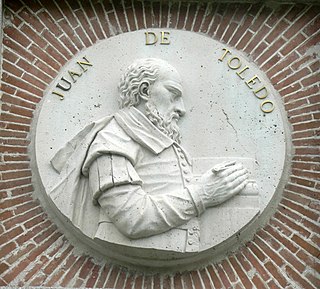
Juan Bautista de Toledo was a Spanish architect. He was educated in Italy, in the Italian High Renaissance. As many Italian renaissance architects, he had experience in both architecture and military and civil public works. Born, either in Toledo or in Madrid around 1515. He died on 19 May 1567 in Madrid, and was buried in Madrid in the choir of the primitive “Convento de Santo Tomás, Iglesia de la Santa Cruz”.
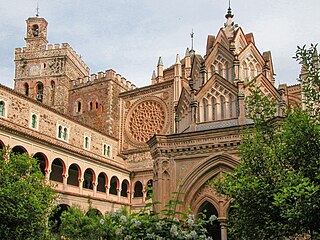
The Royal Monastery of Santa María of Guadalupe is a Roman Catholic monastic establishment in Guadalupe, in Extremadura, Spain. It is located at the foot of the eastern side of the Sierra de las Villuercas and was one of the most important and fine monasteries in the country for more than four centuries. UNESCO declared it a World Heritage Site in 1993.
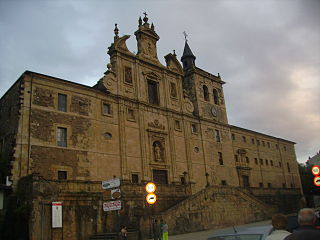
Vilafranca del Bierzo is a village and municipality located in the comarca of El Bierzo, in the province of León, Castile and León, Spain.

Santa María la Real de Nieva is a municipality located in the province of Segovia, Castile and León, Spain, about 30 km (18 mi) northwest of Segovia town. According to the 2010 census (INE), the municipality has a population of 1,193 inhabitants.
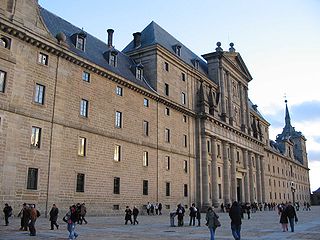
The Herrerian style of architecture was developed in Spain during the last third of the 16th century under the reign of Philip II (1556-1598), and continued in force in the 17th century, but transformed by the Baroque current of the time. It corresponds to the third and final stage of the Spanish Renaissance architecture, which evolved into a progressive purification ornamental, from the initial plateresque to classical purism of the second third of the 16th century and total nudity decorative that introduced the Herrerian style.

Dzidzantún Municipality is one of the 106 municipalities in the Mexican state of Yucatán containing 198.00 square kilometres (76.45 sq mi) of land and located roughly 75 kilometres (47 mi) northeast of the city of Mérida.
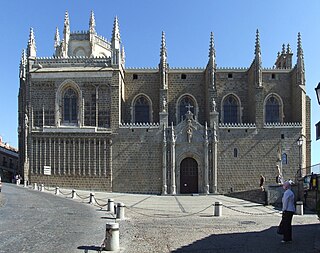
The Monastery of San Juan de los Reyes is an Isabelline style monastery in Toledo, in Castile-La Mancha, Spain, built by the Catholic Monarchs (1477–1504).

Pelayos de la Presa is a municipality in the Community of Madrid, Spain. It covers an area of 7.58 km2. As of 2018, it has a population of 2,475.

The Monastery of San Salvador was a Benedictine monastery in the town of Oña, in the province of Burgos, central Spain, founded in 1011, which lasted until the 19th century.

The Monastery of Sant Jeroni de Cotalba is a monastic building of Valencian Gothic, Mudéjar, Renaissance, Baroque and Neoclassical styles constructed between the 14th and 18th centuries, located in the municipal area of Alfauir, (Valencia), Spain, about 8 km. from the well-known city of Gandia.



